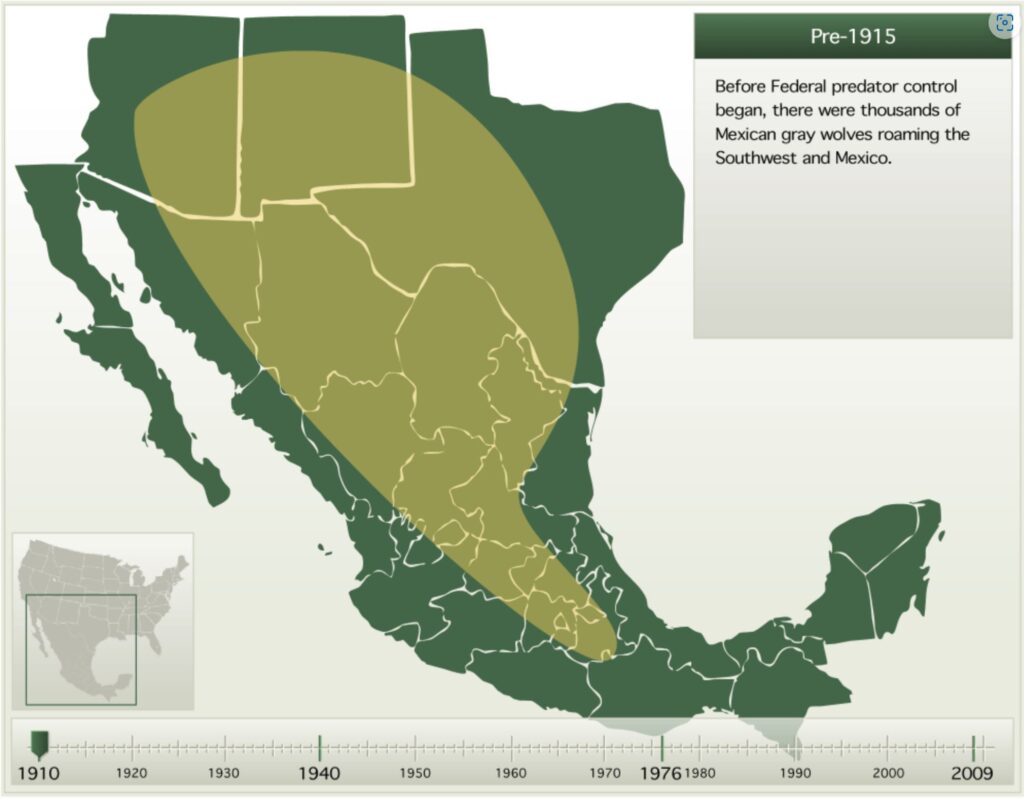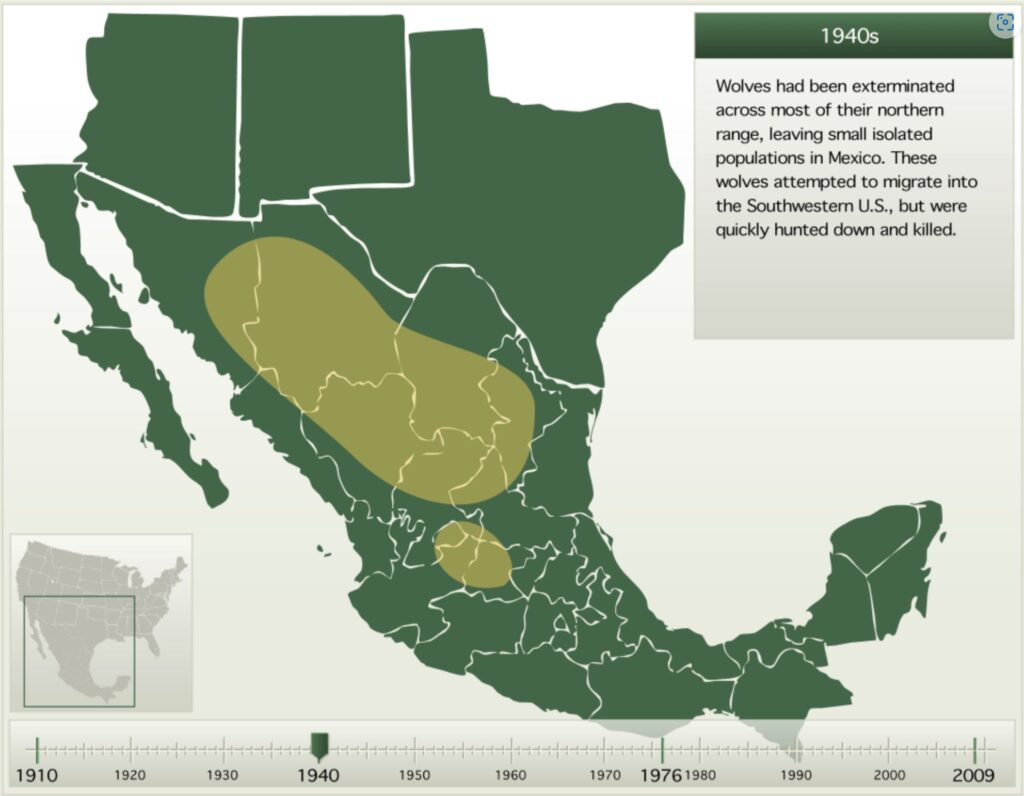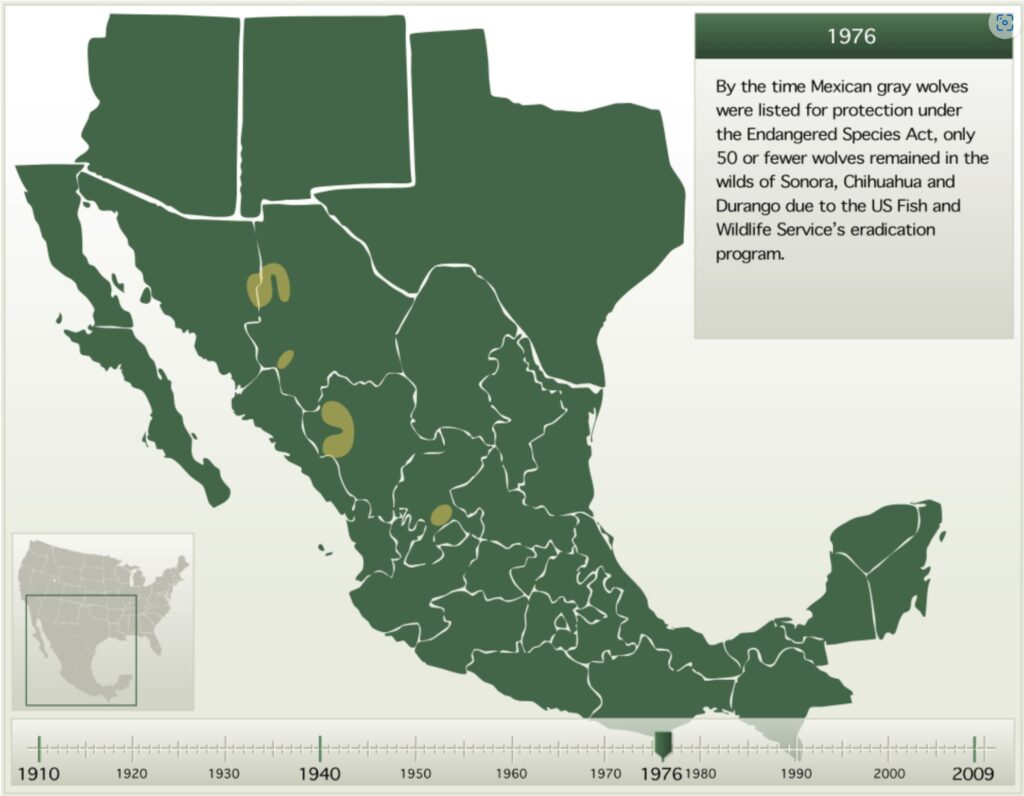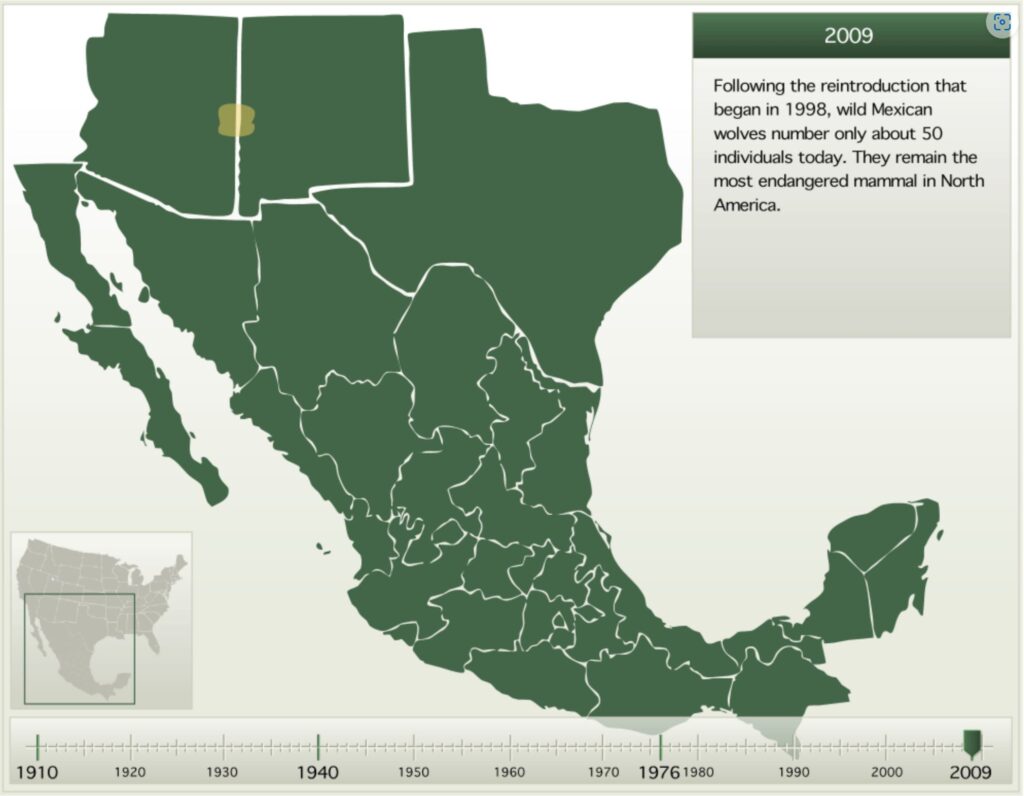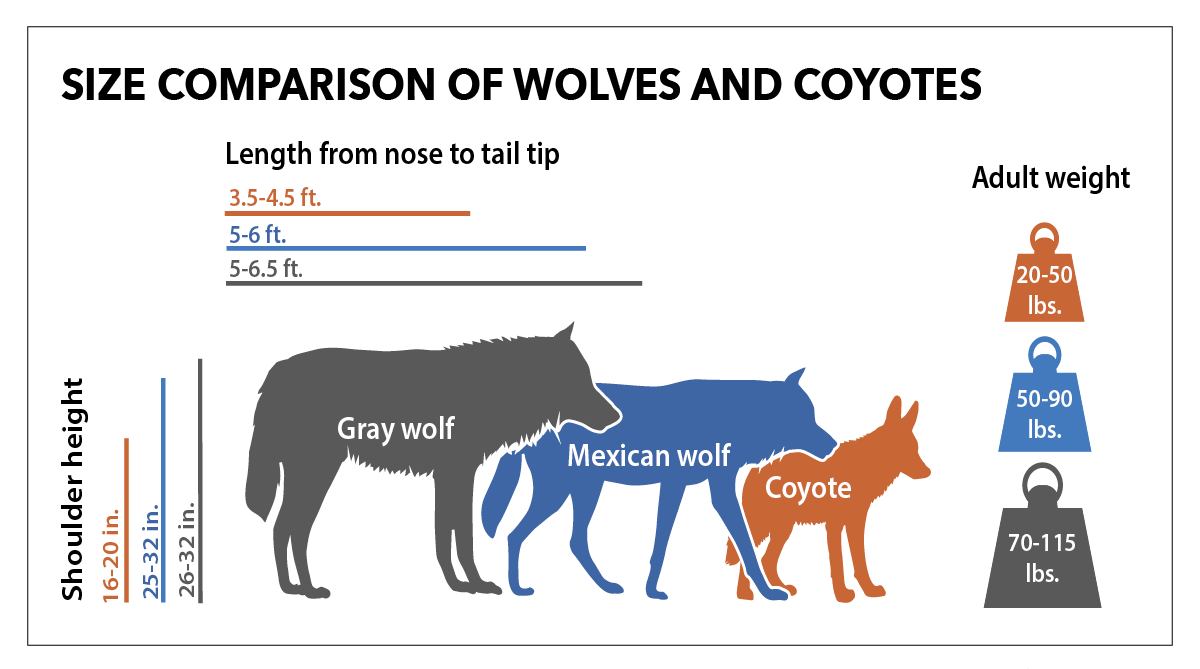WOLF ECOLOGY
Gray wolves in the Southwestern US, developed adaptations to their environment and over time evolved into a genetically distinct subspecies known as the Mexican gray wolf.
THREATS TO WOLVES
As an apex predator, wolf mortality comes from humans and their activities.
ECOLOGICAL ROLE
As with many large carnivores, wolves play a positive role in maintaining ecosystem health and integrity.
COEXISTING
Non-lethal means to deter interactions, reduce livestock mortality and promote coexistence.
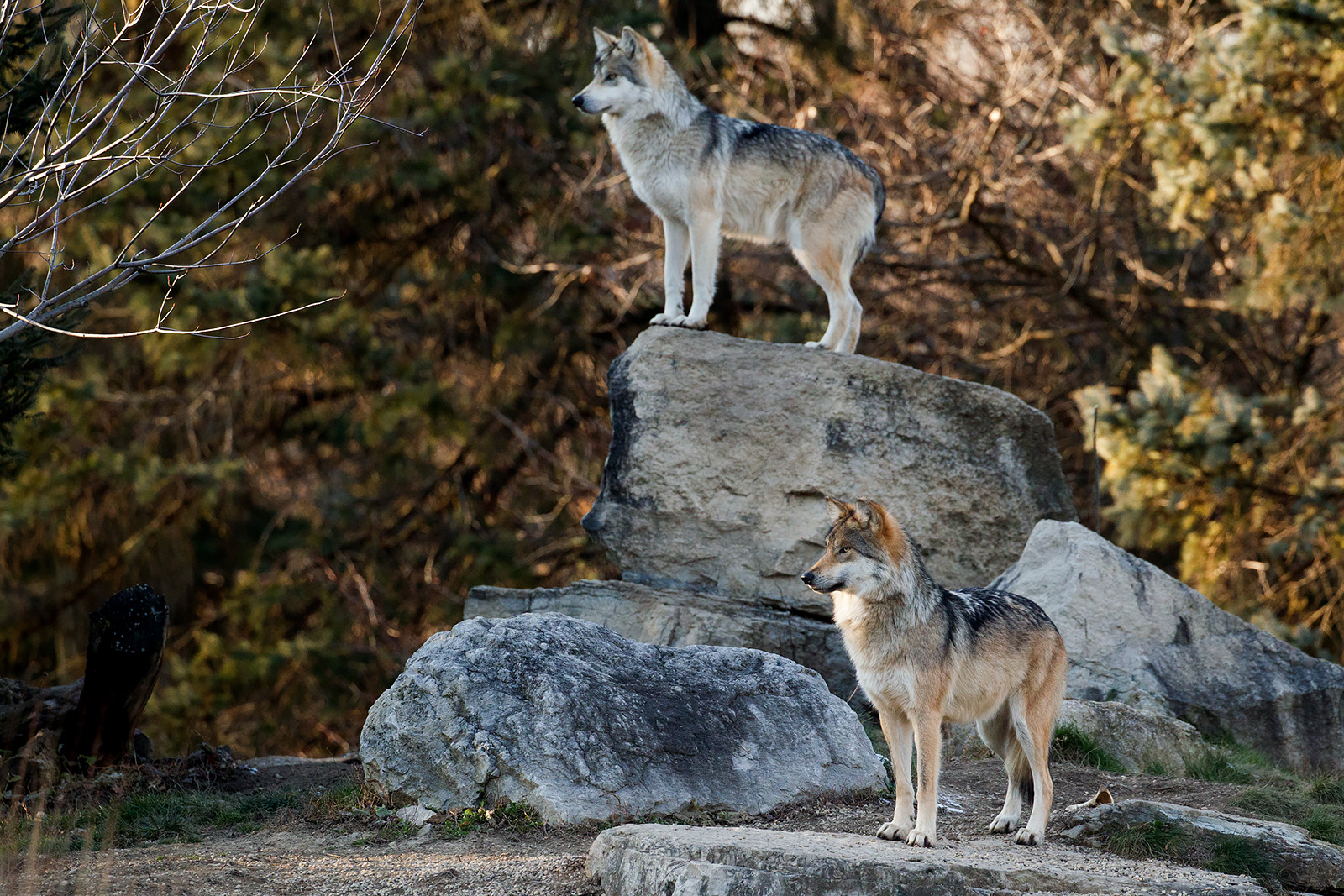

ECOLOGY OF THE MEXICAN GRAY WOLF (CANIS LUPUS BAILEYI)
EVOLUTION
The historic distribution of gray wolves spanned from the Arctic to Mesoamerica. Due to the range of habitats and ecological conditions throughout this range, different variations and local adaptations arose in different gray wolf populations. These variations were usually subtle. However, measurable genetic and physical differences arose in populations that lived substantial distances from one another (Parsons, 2018). Gray wolves in the Southwestern US, in southern Arizona and New Mexico, developed adaptations to their environment and over time evolved into a genetically distinct subspecies of gray wolves known as the Mexican gray wolf. The Sierra Madres region of Northern Mexico and the Sky Island region of the Southwestern US are considered to be the epicenter of the evolution of the Mexican gray wolf subspecies (Parsons & Nicholopoulos, 1995; Parsons, 2018; Leonard et al. 2005). While there have been many arguments against recognizing the Mexican gray wolf as a subspecies of the gray wolf, genetic analyses demonstrate that the Mexican gray wolf is a valid subspecies, and is, in fact, the most genetically distinct subspecies of gray wolf in North America (National Academies of Sciences, 2019). Compared to gray wolves, Mexican gray wolves are distinctly smaller (National Academies of Sciences, 2019). Researchers hypothesize that Mexican gray wolves evolved these smaller body sizes due to the climate of their range in Mexico and in the Southwestern US, as well as smaller prey sizes (Parsons, 2018).
DISTRIBUTION AND HABITAT
Historically, Mexican gray wolves could be found throughout southwestern Texas, southern New Mexico, as far south as central Mexico, and as far north as southern Utah and Colorado (Parsons 1999; USFWS, Mexican gray wolf, 6). However, extensive habitat loss and deliberate extermination by settlers combined with reckless predator eradication programs in the early 1900s caused the extinction of Mexican gray wolves in the wild (Parsons 1999, 2018; Wolf Conservation Center). Populations in Mexico would reach the same fate by the 1980s (Parsons, 1999).
In their current and past ranges, Mexican gray wolves prefer habitats such as montane woodlands with sparse to densely forested mountainous regions, foothills with evergreen oaks, and mixed conifer forests (USFWS, Conserving…). Such habitats provide suitable cover, water and prey (see ‘Diet’ below).
Feature photo: Lobo at Wolf Park Indiana by Monty Sloan Above photo: Wolf Park Indiana by Monty Sloan.
Learn more wolves and the science behind the issues facing this species in these articles:
CRY WOLF – Endangered Mexican Gray Wolf Recovery Is Being “Sabotaged” by Ranchers Who Claim the Canines Are Killing Cattle — and the Federal Employees Who Sign Off on Reports.
By Spencer Roberts,
The Intercept
05.24.2022
Truck, plane, backpack: Inside the extreme effort to save Mexican wolves.
By Karin Brulliard,
The Washington Post
08.25.2022
The Saga of the Mexican Gray Wolf (el Lobo)
By Dave Parsons,
RewildingEarth
06.01.2018
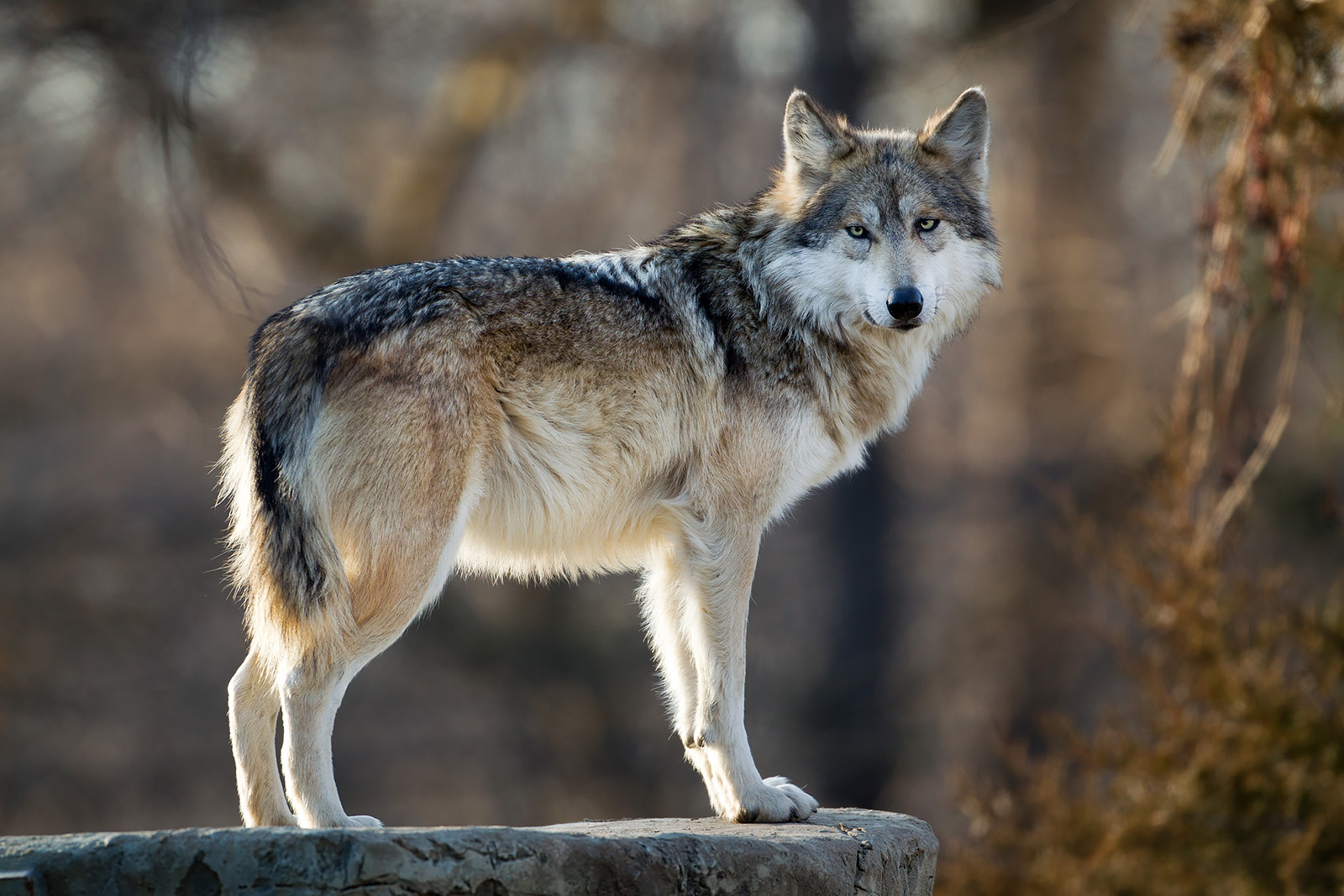
WOLF MANAGEMENT
REINTRODUCTION
The Mexican wolf was listed in the Endangered Species Act (ESA, 1973) as a subspecies of the gray wolf in 1976, imposing a legal obligation to recover the species. This designation jump-started a binational captive breeding program between the United States and Mexico with the capture of the last remaining 7 wild wolves, from which all living Mexican wolves descend. The primary objective of the Mexican Wolf Recovery Plan is to restore the wild population while mitigating inbreeding effects (Harding et al. 2017).
Reintroduction efforts began in 1998 after successful captive breeding of the previously captured wolves, reversing their extinction in the wild–but not by much. Six years after these reintroduction efforts began, nine packs of wolves had been established in Arizona and New Mexico (Fredrickson et al., 2007). As of March 2022, in the wild, there are currently about 196 Mexican gray wolves in the US, and about 40 in Mexico (Lobos of the Southwest; Robinson, 2021). Currently, this re-establishing Mexican wolf population is maintained in an area known as the Blue Range Wolf Recovery Area, which encompasses the Apache-Sitgreaves and Gila National Forests (USFWS, Mexican gray wolf). The Blue Range Wolf Recovery Area consists of a primary recovery zone (red) and a secondary recovery zone (orange), both of which are surrounded by an Experimental Population Area Boundary (green) shown in the map below (USFWS, Mexican gray wolf). The maps above display the historical range of this species before its extinction in the wild.
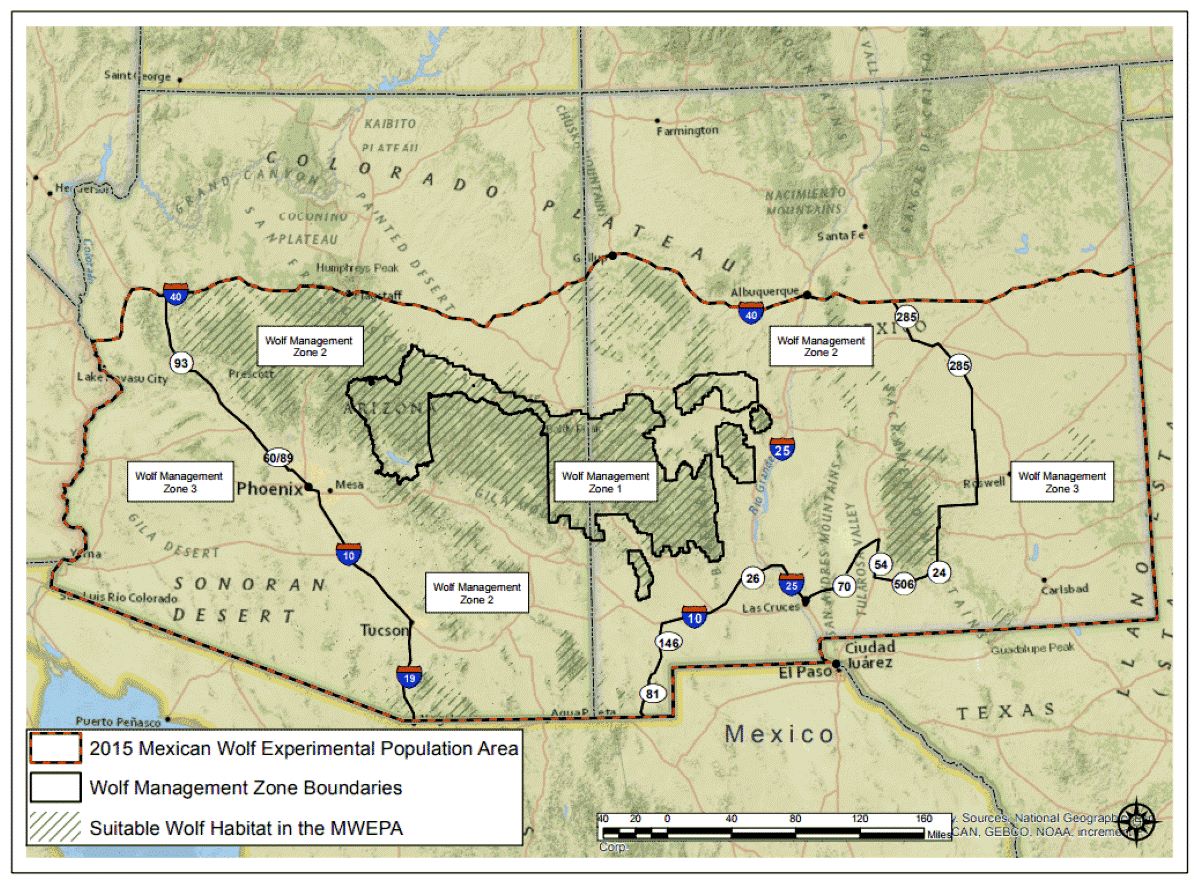
The Primary Recovery Zone is the only area in the Blue Range Wolf Recovery Area where previously captive wolves with no experience in the wild can be initially released. Wolves that were bred in captivity but with some experience in the wild can be released into the secondary recovery area, with some restrictions contingent on land ownership (Federal, tribal or private land). Both zones also serve as dispersal areas that wolves are allowed to occupy. The Mexican Wolf Experimental Recovery Area extends through Arizona and New Mexico south of Interstate 40 and North of Interstate 10. Wolves that are found in this experimental area are managed under the federal government pursuant to the 10(j) management rule. Outside of this experimental area, wolves benefit from full protection under the Endangered Species Act.
Over the past 20 years, habitat suitability assessments have shown that there are only three core habitat areas of sufficient size to support the recovery of the Mexican gray wolf population in the US. One of these areas is the Mexican Wolf Experimental Population Area (MWEPA), another is the Grand Canyon and surrounding public lands in Arizona and Utah, and the third area is managed lands in Northern New Mexico and Southern Colorado (Crumbo, 2022). The northern region of the MWEPA lies within the Mogollon Wildlife Corridor–a proposed 11 million acre managed wilderness area that promotes wildlife connectivity and movement throughout the Sonora, Mexico, the Southern Rockies, and the high plateaus of Utah (Crumbo, 2022).
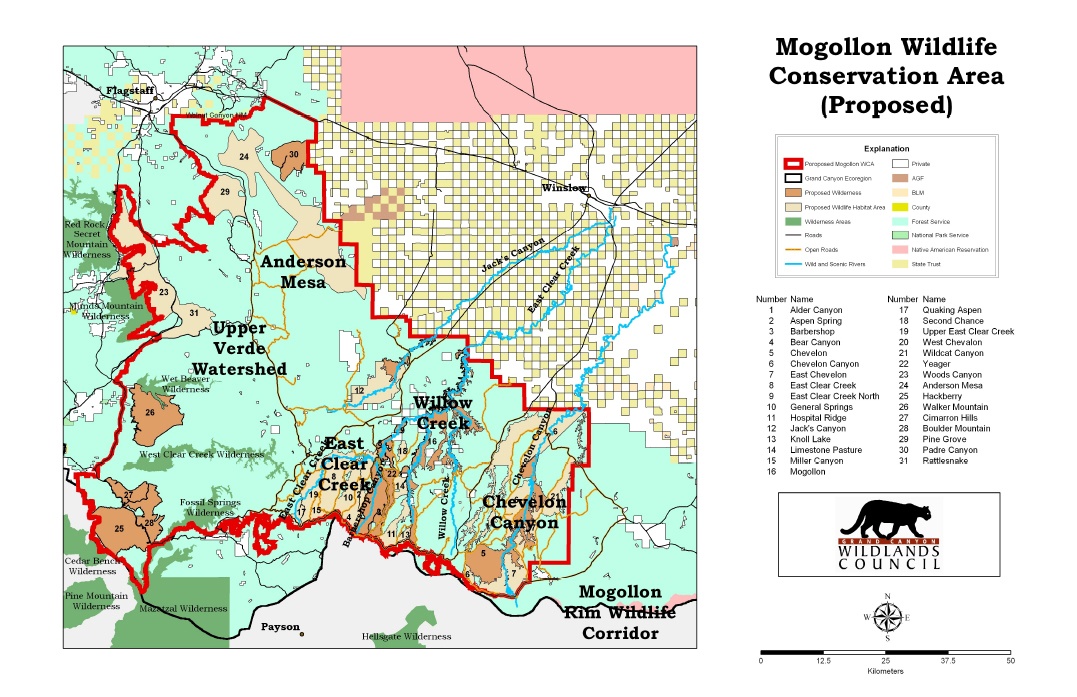
The Primary Recovery Zone is the only area in the Blue Range Wolf Recovery Area where previously captive wolves with no experience in the wild can be initially released. Wolves that were bred in captivity but with some experience in the wild can be released into the secondary recovery area, with some restrictions contingent on land ownership (Federal, tribal or private land). Both zones also serve as dispersal areas that wolves are allowed to occupy. The Mexican Wolf Experimental Recovery Area extends through Arizona and New Mexico south of Interstate 40 and North of Interstate 10. Wolves that are found in this experimental area are managed under the federal government pursuant to the 10(j) management rule. Outside of this experimental area, wolves benefit from full protection under the Endangered Species Act.
Over the past 20 years, habitat suitability assessments have shown that there are only three core habitat areas of sufficient size to support the recovery of the Mexican gray wolf population in the US. One of these areas is the Mexican Wolf Experimental Population Area (MWEPA), another is the Grand Canyon and surrounding public lands in Arizona and Utah, and the third area is managed lands in Northern New Mexico and Southern Colorado (Crumbo, 2022). The northern region of the MWEPA lies within the Mogollon Wildlife Corridor–a proposed 11 million acre managed wilderness area that promotes wildlife connectivity and movement throughout the Sonora, Mexico, the Southern Rockies, and the high plateaus of Utah (Crumbo, 2022).
The purpose of this wildlife corridor is to conserve biodiversity within these Southwest ecosystems by facilitating ecological connectivity and conferring protections for many species found within. The overlap of the Mogollon Wildlife Corridor and the MWEPA provides core recovery area for this subspecies and facilitates connectivity between identified recovery areas (Crumbo, 2022).
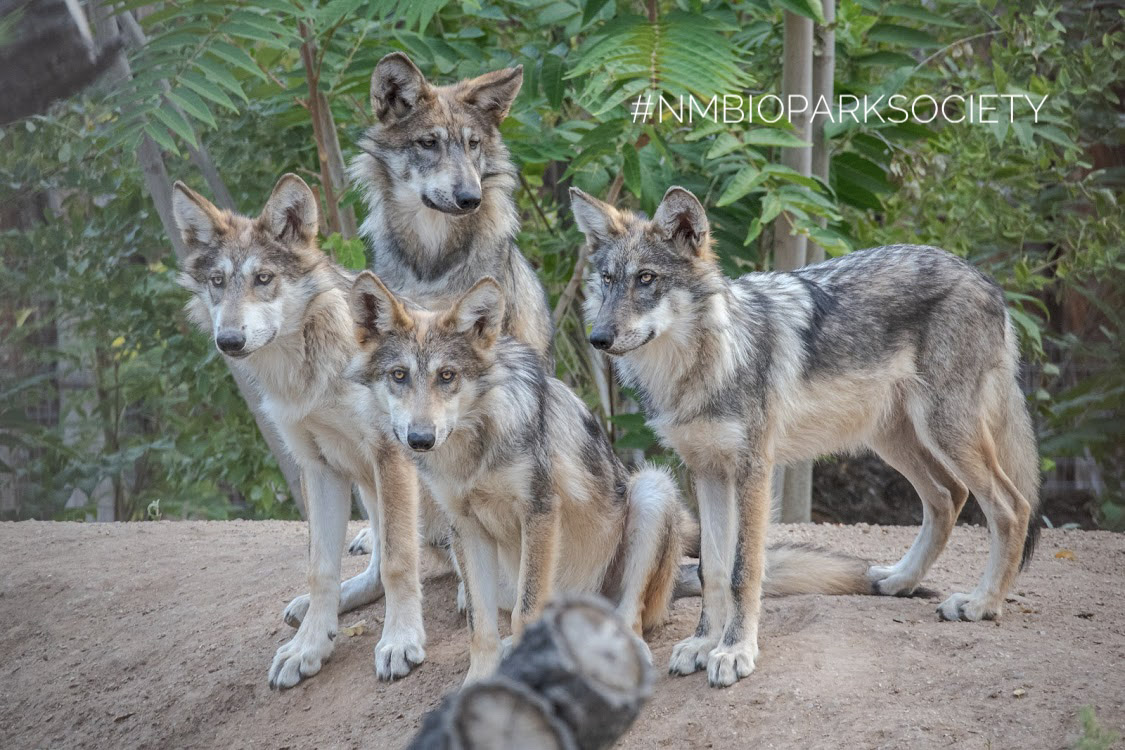
ECOLOGICAL ROLE OF WOLVES
SOCIAL STRUCTURE
As with all gray wolves, Mexican gray wolves are highly social, intelligent, and family-oriented (Packard, 2003). They have an intricate communication system that consists of various vocalizations such as howling, barking, and whining, and they also communicate through scent marking and body language (Harrington & Asa, 2003; USFWS, Conserving the Mexican Wolf).
They live in packs and maintain their home ranges and territories. Mexican gray wolf packs are generally small, consisting of about 4-9 wolves (USFWS, CBD). Each pack consists of an adult breeding pair, 1-2 yearlings, and pups of the year. The territories these packs claim can span up to several hundred square miles (USFWS, CBD).
Within these packs, there is usually only one breeding pair who mate for life. Mexican gray wolves breed in February to March and the gestation period for this subspecies is about 63 days. Females generally give birth to about four to seven pups (USFWS, CBD). There is strong social cohesion within these packs, and adults help raise and care for the pups while they are growing (Lobos of the Southwest).
APPERANCE
Mexican wolves are distinctly smaller than gray wolves; males are rarely over 80 pounds while females are 15 to 20 pounds lighter, and most grow to be about 25-32 inches tall at the shoulder. Their coats are rich in color and are usually a combination of buff, gray, rust, and black shades. One unique feature about the appearance of Mexican wolves is that they often have distinct facial patterns which can be used to distinguish one from another (USFWS).
DIET
Mexican gray wolves are cooperative hunters and this allows them to kill animals far larger than they are (USFWS, Conserving…). The diet of this subspecies mainly consists of animals like elk, mule deer, white-tailed deer, javelina, rabbits, and other small mammals (Lobos of the Southwest; USFWS, Conserving…). Historically, the Mexican wolf would likely have preyed (food habits were not documented) primarily on white-tailed deer and mule deer, with other species serving as alternate prey (Parsons 1996). Recent research on the reintroduced population has identified elk as their primary prey (Reed et al. 2006).
Mexican gray wolves are also opportunistic scavengers, meaning they will often feed on animal remains left behind by other species. For example, these wolves are known to eat domestic animal carcasses and hunter gut piles (Lobos of the Southwest). Wolves will also sometimes kill domestic ruminants. However, the frequency of predation on domesticated animals is often exaggerated. A 2019 report using USDA data showed that 100 Mexican gray wolves only accounted for 0.83% of unwanted cow and sheep losses in Arizona and New Mexico (HSUS, 2019).
Above Graphic: Size Comparison of Wolves and Coyotes by U.S. Fish and Wildlife Service.
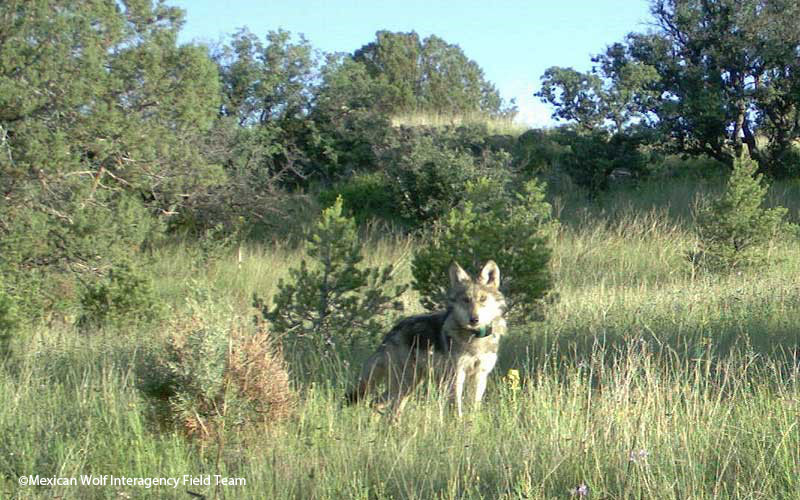
PAST AND CURRENT THREATS
Mexican gray wolves have suffered a long history of mismanagement that contributed to their extinction in the wild by the 1980s, and still to this day suffer from misguided policy decisions.
The extinction of the Mexican gray wolf from the wild was caused by factors such as unregulated hunting for sport and markets, unregulated grazing by domestic ruminants, and legislation passed by congress in 1915 to eradicate large predators from the area (Parsons, 2018). The Endangered Species Act (1973) was passed a few years before their extinction from the wild and Mexican gray wolves were placed on the endangered species list in 1976 (Parsons, 2018; Parsons and Nicholopoulos 1995). Following this listing, as an effort to prevent the extinction of the subspecies, the U.S. Fish and Wildlife Service hired a trapper to capture wolves at the US Mexico border (Parsons, 1996). Five wolves were successfully trapped–four males and one pregnant female (Parsons, 2018). Genetic testing of two other captive lineages determined that they were pure Mexican gray wolves, and this increased the captive population of founders from five to seven wolves (Parsons, 2018).
In 1998, after years of captive breeding, the first 11 Mexican gray wolves were released in Eastern Arizona (Parsons, 2018). Today, there are about 196 Mexican gray wolves in the US, about 40 in Mexico, and over 400 in captivity and in the wild combined (Lobos of the Southwest; Robinson, 2021).
Currently, the two biggest threats to the survival of this subspecies are human-caused mortality and a lack of genetic diversity (Parsons, 2018). Human-caused mortality is the leading cause of death for these animals, accounting for over two thirds (68%) of deaths (USFWS). Moreover, more than half of all deaths are attributed to illegal killings (57%), and recent research indicates that human-caused mortality, especially poaching during times of reduced protection, has been consistently mismeasured and significantly underestimated (Louchouarn et al. 2022, Treves et al. 2017).
The population of Mexican gray wolves in the wild is also threatened by a high inbreeding coefficient. This can contribute to genetic disorders within the population, further jeopardizing their long-term survival (Parsons, 2018).
In addition to human-caused mortality and a lack of genetic diversity, Mexican gray wolves are also threatened by federal regulations and “management” plans that are not scientifically backed (Parsons, 2018). Current federal regulation limits the population of wolves to 325, while the United States Fish and Wildlife Service (USFWS) openly admits that this population threshold places the wild wolf population at risk of extinction (Parsons, 2018). The Mexican gray wolf plan released by the USFWS in 2017 recommends establishing a second population of 200 wolves in Mexico, but scientists state that a total of 525 wolves in separate populations will not support population recovery efforts (Parsons, 2018). Recommendations by scientists have been ignored and these management decisions have instead been influenced by the interests of hunters and ranchers (Parsons, 2018). Furthermore, revisions to the 2017 recovery plan outline addressing poaching (leading cause of morality in the population), but lack detailed information on how this will be accomplished (Project Coyote, 2022). This recovery plan also allows lethal control to be used against Mexican gray wolves in response to conflicts.
Moreover, removals of wolves due to concerns over human-wildlife conflicts also threatens the viability of the population. For example, between 2005-2007 there were 62 temporary/permanent wolf removals, mainly due to claims or concerns over predation on domesticated animals (Wayne & Hedrick, 2011). Recent research suggests legal killing (due to conflicts), removals from the wild, and cryptic poaching are all imperiling Mexican wolf recovery under the ESA (Louchouarn et al. 2021).
In a lawsuit, a federal judge deemed decisions in the 2015 plan to be “arbitrary and capricious”, and two lawsuits have been filed challenging decisions in the 2017 revisions to the Mexican Wolf Recovery Plan (Parsons, 2018). Continued pressure applied to decision making agencies by citizens and scientists is necessary for the conservation of the Mexican gray wolf.
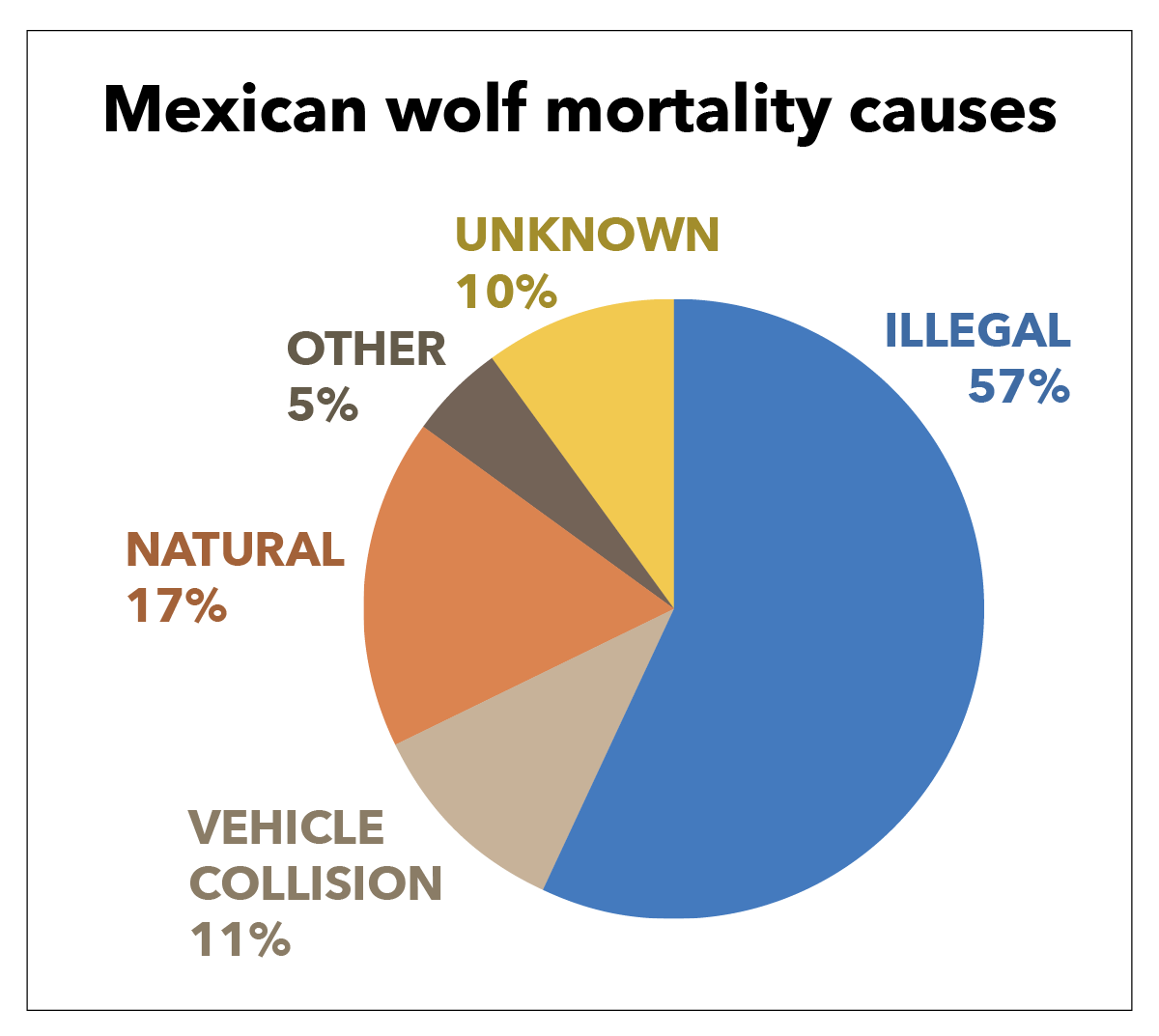
Above Graphic: Mexican Wolf Mortality Causes by U.S. Fish and Wildlife Service.

COEXISTENCE
In order to protect the wild populations of Mexican gray wolves, promoting coexistence between humans and this subspecies is vital. One of their biggest threats is human caused mortality, which is often rooted in retaliatory killings following conflicts with humans and/or wildlife. Helping rural communities that are adversely affected by these conflicts coexist with wolves can help prevent excessive human-caused mortality.
Compensation for losses of domesticated ruminants is the most common intervention strategy to address losses to Mexican gray wolves (Smallidge et al., 2008). These compensation programs seek to promote acceptance of wolves and increase acceptance of predation (Smallidge et al., 2008). In the 12 years following the reintroduction of the first Mexican gray wolves in the wild, a compensation program was established by Defenders of Wildlife that paid ranchers the market value for their animal-related losses caused by wolves (Miller, 2019). Despite the goals of these programs, they are not without controversy. For instance, though these programs offset some of the costs associated with predation, ranchers report that the value of this loss is far greater than the amount compensated (Smallidge et al., 2008). Additionally, they do not actually address the cause of the conflict or address management decisions (Smallidge et al., 2008). Finally, research suggests compensation payments do not improve tolerance towards wolves or disincentivize approval for lethal control (Naughton-Treves et al. 2003)
As for conflict-mitigating interventions, there is not one technique that is the most effective in every scenario. The use of range-riders and herders has proven to be an effective tool to promote human-wolf coexistence. These range-riders provide on the ground human presence, support dealing with the health and distributions of domestic ruminants, and identify interactions between those animals and carnivores (Lance et al., n.d.). They collect information regarding missing domestic animals, intervene non-injuriously if a conflict occurs, and communicate with agencies to integrate conflict avoidance techniques in grazing management (Miller, 2019).
Aside from the use of range-riders and monetary compensation, a variety of other tools exist to promote coexistence between Mexican gray wolves and humans. One technique involves ranchers planning the calving season of their animals after the elk calving season, as this will lead to an increase in the wolves’ prey base and consequently decrease domestic animal predation (Breck et al. 2011). In fact, research suggests changes in husbandry practices may be more effective at mitigating conflicts than compensation (Breck et al. 2011). Other techniques involve the use of fladry, fencing/barriers, and light/sound deterrents, in addition to management actions like diversionary feeding.
LITERATURE CITED
Breck, S. W., Kluever, B. M., Panasci, M., Oakleaf, J., Johnson, T., Ballard, W., Howery, L., & Bergman, D. L. (2011). Domestic calf mortality and producer detection rates in the Mexican wolf recovery area: Implications for livestock management and carnivore compensation schemes. Biological Conservation, 144(2), 930–936. https://doi.org/http://dx.doi.org/10.1016/j.biocon.2010.12.014
Center for Biological Diversity. (n.d.). Natural History. Mexican Grey Wolf. Retrieved September 21, 2022, from https://www.biologicaldiversity.org/species/mammals/Mexican_gray_wolf/natural_history.html#:~:text=HABITAT%3A%20Mexican%20gray%20wolves%20are,far%20south%20as%20central%20Mexico
Crumbo, K. (2022, February 2). The Mogollon Wildlife Corridor: A Big Step Toward Half Earth and Beyond. Rewilding. Retrieved September 22, 2022, from https://rewilding.org/the-mogollon-wildlife-corridor-a-big-step-toward-half-earth-and-beyond/
Devoid, A. (2018, September 11). New research finds Mexican gray wolves aren’t part dog after all. The Arizona Republic. Retrieved September 21, 2022, from https://www.azcentral.com/story/news/local/arizona-environment/2018/09/11/researchers-say-mexican-gray-wolf-dna-isnt-contaminated-dog-genes/904720002/
Fredrickson, R. J., Siminski, P., Woolf, M., & Hedrick, P. W. (2007). Genetic rescue and inbreeding depression in Mexican wolves. Proceedings of the Royal Society B: Biological Sciences, 274(1623), 2365–2371. https://doi.org/10.1098/rspb.2007.0785
Harding, L. E., Heffelfinger, J., Paetkau, D., Rubin, E. S., Dolphin, J. & Aoude, A. (2017) ‘Reply to Hedrick: Genetics and recovery goals for Mexican wolves’, Biological Conservation, vol 206, no 212-213.
Harrington, F. H., Asa, C. S., Mech, L., & Boitani, L. (2003). Wolf communication. In L. D. Mech & L. Boitani (Eds.), Wolves: Behavior, ecology, and conservation (Vol. 3, pp. 66–103). University of Chicago Press.
Humane Society of The United States. (2019). Government data confirm that wolves have a negligible effect on U.S.cattle and sheep industries. Dated: Mar. 6, 2019. Retrieved February 2, 2023 from https://www.humanesociety.org/sites/default/files/docs/HSUS-Wolf-Livestock-6.Mar_.19Final.pdf
Lance, N., Primm, S., & Inman, K. (n.d.). Wolf Resource Guide Hands – On Resource Guide to Reduce Depredations. Denver; Colorado Parks & Wildlife .
Leonard, J., Vilá, C. & Wayne, R. (2005) ‘Legacy Lost: Genetic variability and population size of extirpated US gray wolves’, Molecular Ecology, vol, no 126, pp 198-206
Lobos of the Southwest. (n.d.). History of the lobo – A Brush with Extinction. About Mexican Wolves. Retrieved September 16, 2022, from https://mexicanwolves.org/history/
Lobos of the Southwest. (n.d.). Natural role – About Mexican Gray Wolves. Lobos of the Southwest. Retrieved September 21, 2022, from https://mexicanwolves.org/natural-role/
Louchouarn, N., Santiago-Ávila, F. J., Parsons, D. R., & Treves, A. (2021). Evaluating how lethal management affects poaching of Mexican wolves. Royal Society Open Science, 8(200330). https://doi.org/https://doi.org/10.1098/rsos.200330
Miller, C. (2019, August 16). Coexisting with Mexican gray wolves: A Tale of Partnerships. Defenders of Wildlife. Retrieved September 22, 2022, from https://defenders.org/blog/2019/08/coexisting-mexican-gray-wolves-tale-of-partnerships
National Academies of Sciences, Engineering, and Medicine; Division on Earth and Life Studies; Board on Agriculture and Natural Resources; Board on Life Sciences; Committee on Assessing the Taxonomic Status of the Red Wolf and the Mexican Gray Wolf. (2019). Evaluating the Taxonomic Status of the Mexican Gray Wolf and the Red Wolf. National Academies Press (US)
Naughton Treves, L., Treves, A., & Grossberg, R. (2003). Paying for Tolerance: Rural Citizens’ Attitudes toward Wolf Depredation and Compensation. Conservation Biology, 17, 1500–1511.
Packard, J. M. (2003). Wolf Behavior: Reproductive, Social, and Intelligent. In L. D. Mech & L. Boitani (Eds.), Wolves: Behavior, ecology, and conservation (pp. 35–65). University of Chicago Press.
Parsons, D. (1996) ‘Case study: the Mexican wolf’, New Mexico Journal of Science, vol 36, no 101-123. Available from: https://wolfology1.tripod.com/id181.htm.
Parsons, D. R. (1999) ”Green fire’ returns to the Southwest: Reintroduction of the Mexican wolf’, Wildlife Society Bulletin, vol 26, no 799-807.
Parsons, D. (2018, June 1). The saga of the Mexican Gray Wolf (El Lobo). Rewilding. Retrieved September 16, 2022, from https://rewilding.org/the-saga-of-the-mexican-gray-wolf-el-lobo/
Parsons, D. R., and J. E. Nicholopolous. 1995. The status of the Mexican gray wolf. Pages 141-146 in L. N. Carbyn, S. H. Fritts, and D. R. Seip, editors. Ecology and conservation of wolves in a changing world. Canadian Circumpolar Institute, Edmonton, Alberta, Occasional Publication 35.
Project Coyote. (2022, April 14). Media release: U.S. Fish and Wildlife Service releases another inadequate revision to Mexican gray wolf recovery plan. MEDIA RELEASE: U.S. Fish and Wildlife Service Releases Another Inadequate Revision to Mexican Gray Wolf Recovery Plan. Retrieved September 21, 2022, from https://projectcoyote.org/usfws-releases-another-inadequate-revision-mexican-gray-wolf-recovery-plan/#:~:text=Currently%2C%20human%2Dcaused%20mortality%20is,biggest%20hindrance%20to%20species%27%20recovery
Reed, J. E., Ballard, W. B., Gipson, P. S., Kelly, B. T., Krausman, P. R., Wallace, M. C., & Wester, D. B. (2006). Diets of Free-Ranging Mexican Gray Wolves in Arizona and New Mexico. Wildlife Society Bulletin, 34(4), 1127–1133. https://doi.org/10.2193/0091-7648(2006)34[1127:DOFMGW]2.0.CO;2
Robinson, M. (2021, December 13). Wandering Mexican gray wolf in New Mexico blocked by Border Wall. Center for Biological Diversity. Retrieved September 21, 2022, from https://biologicaldiversity.org/w/news/press-releases/wandering-mexican-gray-wolf-in-new-mexico-blocked-by-border-wall-2021-12-13/
Smallidge, S. T., Halbritter, H., Ashcroft, N. K., & Boren, J. C. (2008). (rep.). Review of Livestock Management Practices to Minimize Livestock Depredation by Wolves: Applicability to the Southwest (pp. 1–10).
Treves, A., Artelle, K. A., Darimont, C. T., & Parsons, D. R. (2017). Mismeasured mortality: correcting estimates of wolf poaching in the United States. Journal of Mammalogy, 1–9. https://doi.org/10.1093/jmammal/gyx052
U.S. Fish & Wildlife Service. (n.d.). Conserving the Mexican Wolf: U.S. Fish & Wildlife Service. FWS.gov. Retrieved September 21, 2022, from https://www.fws.gov/program/conserving-mexican-wolf/species
U.S. Fish and Wildlife Service. (n.d.). Mexican gray wolf: Environmental impact statement. Mexican Gray Wolf: Release Boundaries. Retrieved September 16, 2022, from http://mexicanwolfeis.org/process/release-boundaries/#:~:text=Wolves%20with%20experience%20in%20the,of%20Interstate%2010%2C%20as%20shown.
Wayne, R., & Hedrick, P. (2010). Genetics and wolf conservation in the American West : lessons and challenges. Heredity, 107(1), 16–19. https://doi.org/10.1038/hdy.2010.147
Wolf Conservation Center. (n.d.). Mexican Gray Wolf. Retrieved September 16, 2022, from https://nywolf.org/learn/mexican-gray-wolf/#:~:text=The%20Mexican%20wolf%20was%20listed,not%20been%20confirmed%20since%201980

